#the witch part one subversion
Explore tagged Tumblr posts
Text
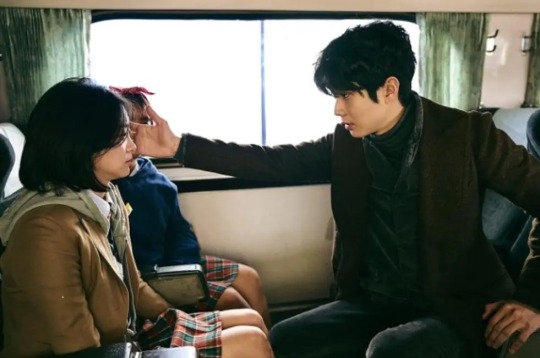
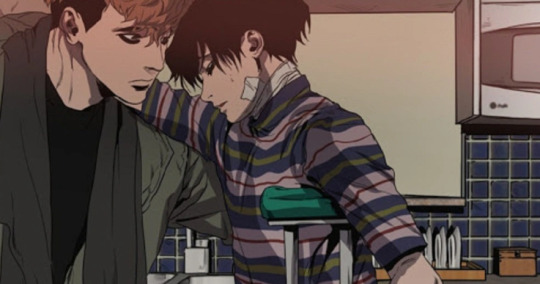
Propaganda:
Ja Yoon and The Nobleman: Both were scientific experiments, but she managed to escape while he did not. Now he enjoys tormenting a seemingly amnesiac girl and threatening to kill those she loves, all for fun.
Yoonbum and Sangwoo: None submitted.
#polls#most fucked up ship tournament#most fucked up ships#the witch part one subversion#killing stalking#manhwa#webtoon
15 notes
·
View notes
Text





If you are confused watching 'The Tyrant' on 'Disney Plus' - it's a mini show based on the same universe / time line as 'The Witch' part 1 & 2.
Hope season 2 gets picked up and they make it at least 8 episodes. Or maybe make a movie.
If you like 'The Witch', you'll enjoy this
#The Witch: Part 1 - The Subversion#The Witch: Part 2. The Other One#the tyrant#disney plus#k show#South Korea tv#fantasy sci fi#k thriller#k action
11 notes
·
View notes
Text
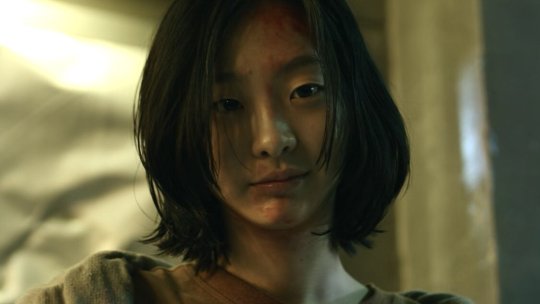
The lethal gaze be like:
21 notes
·
View notes
Text
okay so idk but i have this sudden fanfic idea because of how hyped i am abt jjk while i watched both movies of The witch part 1 and 2. i suddenly imagined how fuckin sick it will be to have an oc or yn that is from The witch but got the attention of jujutsu sorcerers because of how powerful and questionable how she got her power from. they thought she was like Satoru but she she isn’t and thought she would be more like Sukuna then she becomes the greatest enemy of jjk world but Satoru found her weakness or something and even sukuna helped them HAHAHAHAHAHAHAHAHAHA idk it’s so cool in my head.
#jujutsu sorcerer#jujutsu kaisen hcs#gojo satoru#jujutsu gojo#jujutsu sukuna#jujutsu kaisen#headcanon#fanfic#nobelthewitch#the witch part 1 subversion#the witch part 2 the other one
4 notes
·
View notes
Text

Day 13

White: Melody of Death (Hwaiteu: Jeojooui Mellodi - 화이트: 저주의 멜로디)
Year Released: 2011
Run Time: 1hr 46m
Director: Gok Kim, Sun Kim
Rating: PG-13
Genres: Horror, Music, Mystery
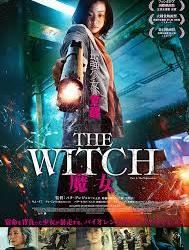
The Witch: Part 1. The Subversion (Manyeo - 마녀)
Year Released: 2018
Run Time: 2hr 5m
Director: Park Hoon-jung
Rating: Not Rated
Genres: Action, Mystery, Sci-Fi
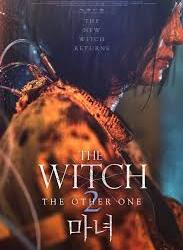
The Witch: Part 2. The Other One (Manyeo: Part2. The Other One - 마녀 Part2. The Other One)
Year Released: 2022
Run Time: 2hr 17m
Director: Park Hoon-jung
Genres: Action, Mystery, Thriller
#31 days of halloween#halloween#31 days of horror#happy halloween#horror#horror films#horror movies#korean horror#korean films#korean movies#korean#day 13#white: melody of death#the witch: part 1 the subversion#the witch: part 2 the other one
0 notes
Text
Thinking about the way dungeon meshi does queer horror. Using horror to tell queer stories is already subversive, but dungeon meshi subverts it even more
Normal queer horror is like. A monsterous desire and immortal love of something isolated/hated and the uncontrollable but suppressed need to consume someone to live and they only die if you break/pierce their heart. its great.
In dungeon meshi, the group is STARVING. they do things the way they're expected to and they're so deprived that eventually, one of them is consumed by that monsterous desire.
Then when Falin becomes a monster, she doesn't eat Marcille because she doesn't NEED to, Marcille already offered herself up as part of Falin by mixing her own blood with the dragon's for the resurrection.

Also Marcille is a monster too!! She doesn't need to be turned by Falin. She's a 'witch' doing black magic for one but she's also very vampiric
Her name is super vampirey especially given one of the translation spellings was Marcilla, an annogram of Carmilla*. And Marcille is very similar to Marceline from Adventure Time so it's a name with heavy connotations to me. Also her staff is Ambrosia which means immortal.
*ps Carmilla is the original modern vampire that inspired Dracula and also a lesbian. she used annagrams of her name (Marcilla, Mircalla, Millarca) to disguise herself across hundreds of years.
Marcille is like. a vampire in that death is a big part of her theme. She can breathe that immortality into someone else using her resurrection black magic and death is a huge part of her character. She wants them to live as long as she does. To make them immortal. Like. Like a vampire. Vampires which are unholy when her love interest is a cleric.
But once again this is subverted!! she doesn't 'turn' Falin, she makes her undead by giving her own blood instead of taking Falin's. Falin becomes a monster not because she's attacked or turned, but because her DNA, something INHERENT about her is now intertwined with the monster. so a god-like figure merges them. Then the only way to free her from that frenzy and grant her autonomy again is to finally consume her. something inherently lesbian about all that i think idk about you
#grain of salt#im anime only so I don’t know if the eating her solution works#but whatever happens I BET it’ll work with this queer horror metaphor#dungeon meshi#delicious in dungeon#dungeon meshi analysis#farcille#falin touden#marcille donato#queer horror#lesbian vampires make me crazy#i have sooo much to say abuot the queer horror of this show#genuinely how does anyone say theres no romance or theyre not gay because. yeah its only implied but#if you have to make them kiss to prove theyre in love then theyre not really in love#you should be able to tell from implication and interaction and you DEFINITELY can with the way they talk about each other#'marcille.... her name is marcille' with that little smile. thats a girl in love#my posts
474 notes
·
View notes
Text
Nothing has proved to me more that people don’t actually mind oppressive systems in real life than oppressive systems in fiction.
For example, the four houses in Harry Potter. We are explicitly told that every witch or wizard that joins Slitherin eventually turns bad, or is a narcissist, or is in some way a shitty ass person. Likewise we are told the Hufflepuff are kinda the dumb ones that just sorta vibe. Even Grifindore aren’t really smart per-say, they just have more gusto and bravery than other houses. And like this whole system is designed to sort people into groups and we are shown that being sorted so early in your life is kinda fucking detrimental to the rest of your life?? Like it’s a fucked up system.
And then IRL people are INCREDIBLY LOYAL to the idea of being sorted into these 4 groups. And JK Rowling being a horrific TERF doesn’t seem to dissuade people from trying to figure out which house they’d belong to.
Then we have the subversive parody of Harry Potter in The Owl House and their Coven system. The covens are designed to seal off your magical power so you can never do anything other than that ONE piece of magic for the rest of your life. And you have to pick that covens track in high school at the latest.
This is seen as SEVERELY limiting on its own… but then it’s revealed that this whole system was designed to drain all witches of their life force and essentially KILL EVERYONE in a mass genocide.
And yet people IRL still like to imagine which coven track they’d be apart of.
Then there’s Severance with its whole dystopian horror concept of being able to separate your brain so you never have to experience work, or pain, or suffering… at the cost of forcing one half of your consciousness to ONLY EXIST to experience work, pain, and suffering.
One of the ways they keep the “innies” from rebelling is to tell them information about their “outies” lives. “Your innie likes to swim. Your innie is kind to strangers. Your innie always sneezes twice.” This is meant as a condescending way to control the innie by treating them like a fucking BABY.
And guess what I see every week when Severance comes back on? People in social media posting about how their “innies enjoys ____!”
It’s like we are HARDWIRED into tribalism and we can’t HELP but sort ourselves into these systems. Even when the stories and shows are telling us “THIS IS FUCKED UP!”
Is it any wonder then when Alt-Right Nazis realized they could harness this and made everything in the past 15 years about “us Va them” and makes all politics about being part of a “team” of some kind that people JUMPED ON BOARD to it?
22 notes
·
View notes
Note
Hey, I'm doing a presentation workshop at work and as part of it we each have to give a presentation about something we're passionate about, so I'm doing RWBY and focusing on the subversion of tropes (like how Jaune and Ruby have swapped the traditional male anime protagonist role and the backup role usually for a girl around) and multiple allusions for each character (Norse, LOTR, fairy tale, wizard of Oz etc) and how they're shown.
Do you have any favourite theories or allusions around the main two teams, the Ozluminati or STRQ? Thanks!
Oooh, sounds fun! XD
That's a great question, and honestly when it comes to Team RWBY, I think my favorite allusions are simply how the story flips and twists the core allusions of the main girls:
Ruby is a Little Red Riding Hood who, rather then being menaced and hunted by a monster in the woods, is HERSELF a hunter of monsters. A Red Riding Hood who goes into the woods to hunt the monsters so that others may be safe.
Weiss is a Snow White who is both the 'Disney Princess' AND the 'Knight in Shining Armor'. A girl who probably would have been pushed into a traditional 'princess' role by her controlling, abusive father, but who instead essentially became the 'Knight' to rescue herself, and strives to be a noble figure to help others as well.
And of course, Blake being BOTH the 'Beauty' and 'The Beast' of her allusion. With Yang complimenting said allusion by likewise being both the 'Beast' to Blake's 'Beauty' and the 'Beauty' to Blake's 'Beast'. And how Adam manages to likewise represent both Gaston and the Cursed Rose.
There is also my 'Odin!Ruby' theories, though I will freely admit those are more 'fun headcanons' at the moment, rather then something really held up by the narrative.
There is also something just so damn cool about Salem essentially being 'The Wicked Witch of the West' crossed with SAURON (with a bit of 'Galadrial if she took the Ring' vibes thrown in) XD
And Cinder presenting just this AMAZING dark, tragic twist on Cinderella as a villain origin story. Where Cinderella finally fights back and even KILLS her wicked and cruel step-mother and sisters who so long kept her under their boot, only for the people/person she trusted most to turn on her and side with those very oppressors. Showing just how much the society she lived in was entirely okay with the terrible oppression that was done to her.
The fact that the show manages to give us a Wizard of Oz who really is a powerful wizard, yet also STILL turns out to be a massive fraud who lied to everyone.
Even after all this time, I think some of my favorite allusions in the show are still the ones at the core of the main characters.
#rwby#rwby ask#tahnex ask#rwby allusions#Team RWBY#Ruby Rose#Weiss Schnee#Blake Belladonna#Yang Xiao Long#Salem#Cinder Fall#Ozpin
37 notes
·
View notes
Note
Random question incoming.
What is you favorite Discworld subseries? (Watch, Witches, Wizards, Death or stand alones?)
ohhhh okay so by random question, i assume you meant "ramble for ten solid minutes about one of my oldest special interests", right?
SO. gun (gonne) to my head, i would probably say the watch books because night watch is one of my favourite books of all time, not just my favourite discworld books. i also read books like jingo at a formative age and they have stayed with me SO MUCH. ALSO. the subversion of the fantasy tropes in discworld is one of my favourite things about the series, and one of the subversions of all time has got to be carrot's "birthright" stuff. as someone who is pretty strongly anti-monarchy, this storyline and the ways it informs the relationship between carrot and vimes is SO GOOD. also also, some of my favourite secondary characters come to us via the watch books, and sam and sibyl are one of my all time favourite fictional relationships ("not a gentleman but a gentle man" rewired my brain istg)
THAT SAID. the first discworld book i read was reaper man, and i do think some of the best philosophy in the series comes in the death books. what can the harvest hope for, if not the care of the reaper man? i'm not religious or spiritual in the slightest but GOD that line makes me wish i was. and of course the whole discussion in hogfather about justice and fairness, the big lies and the little lies. they're just untouchable. and without the death books, we wouldn't have SUSAN. character of all time, SUSAN STO HELIT. she's cynical, she's stern, she's a born educator who knows that children are horrible little gremlins, she's DEATH'S GRANDDAUGHTER. no one's doing it like her.
and then THAT SAID, the witches??? idk man, i really really struggle to separate these from the death books in terms of my ranking because granny?? hello??? i have been able to read the shepherd's crown only twice because i can't see through my fucking tears, good lord. the part in witches abroad where she confronts lily ("because i had to be the good one") speaks to some complicated family stuff of my own and will forever have a place in my heart. and the part where she's trapped in the mirrors and has to find "the real one" and just immediately looks down at herself and says "this one" is like. that's what i aspire to be and to have. and GOD, as a fat, anxious little kid, agnes/perdita was just such a revelation to me. and of course, via the OG witches we get tiffany aching, my queen of cognition and meta-cognition. and of course, because i love a horny old lady, NANNY OGG. and GREEBO. and MAGRAT, my beloved. god, there's just so much in these books to adore.
so the wizards, i adore them as characters, but the wizard focused books generally aren't my favourites, possibly because so many of them are from so early on when i feel like pterry was still finding his voice/world etc. so while the archchancellor (aka fantasy ron swanson c'mon) is a delight and while as someone who works in academia, the commentary on universities is EVERYTHING to me, they don't tend to make the top of my list.
the standalones are easy to lose sight of, because of the (general) lack of tie-in to the wider world BUT a couple of special shout outs:
moving pictures (or is this considered a wizards book?) for the NEVER ENDING parade of puns and references, some of which i STILL get for the first time when i re-read
small gods. THIS BOOK. THIS BOOK, y'all. there are so many things i adore about it, but possibly nothing more than the scene in the inquisitors' office that gives rise to these lines: "And it all meant this: that there are hardly any excesses of the most crazed psychopath that cannot easily be duplicated by a normal, kindly family man who just comes in to work every day and has a job to do."
monstrous regiment. WHAT IN THE GENDER. i feel like this, along with things like the development of the dwarfs throughout the series really show what an amazing, kind, loving and thoughtful a person pterry was. GOD i miss him.
lol okay this got even longer than anticipated and i'm STILL NOT DONE. one of the things i love best about this series is that there really is something for everyone. my dad is NOT a fantasy reader in the slightest, but even he liked men at arms and guards! guards!. a friend of mine was struggling to get into the books but because i Know Him and his interests i was able to say "bro. carpe jugulum. immediately." my mum wasn't much of a reader at the time, but i knew that equal rites would get her, and it did.
exTREMEly tl;dr:
1. watch books 2/3. (impossible to separate) death books and witches books 4. standalones 5. wizards
lmao, thank you so much for the ask, i just enjoy thinking and rambling about these books so much 💕
"do you not know that a man is not dead while his name is still spoken?" gnu sir terry.
14 notes
·
View notes
Text
Part 1: Why is Nettles black?
TLDR: George subverts a bunch of stereotypes specifically tied to black women in media with Nettles, she's black, innocent, not practising magic, young, doesn't nurture or take care of anyone and her own sexual experiences aren't exploited in her narrative rather in a projection of someone. The closest she comes to any other race is when they call her a dragon lady at the end, which is an Asian stereotype but not something invoked to critique. Nettles is black.
So I said it before, but now again, this is a two part post because when it comes to this character, I think the relevance of her race is often lost because of what is percieved as a greater narrative purpose. But Nettles race and specifically her being black is important to her story. The next part will delve into her role in the narrative as a black girl, but this part is generally why I can say she's black with confidence using the written narrative.
STEREOTYPES/ TROPES
There are multiple stereotypes used to box black women in specifically from the inception of race in media. Some of the most prominent are the (in great reduction to the nuance):
Sapphire: angry, loud, and rude black woman
Jezabel: sex driven, lust bound, and seductive black woman
Mammy: nurturing, sexless and typcially bigger black woman.
Magical black woman: linked to some sort of witchcraft practice but not central to the narrative. Not to be confused with the magical negros trope which is different.
Tragic Mulatto: mixed raced stereotype that they belong no where.
Ghetto: I saw this recently, but this is basically the hood girl trope.
Grown black girl: this is when they treat black girls as older than they are, like adults when they are kids.
These concepts have smaller sub tropes, and there are more stereotypes, but even to this extent, there is a battle with media literacy when it comes to the way people see black female characters in media.
For the sake of Nettles, we'll be covering all in the next part. Along with the history, seeing as most if not all the origins for these tropes can be found in Slavery.
SUBVERSIONS.
With the sapphire trope, George manages to give Nettles these characteristics and add on to them, so while they are a part of her character, there is depth and nuance. She is rude, called foul-mouthed in the narrative, but she is also fearless and smart. She never gets angry in the written narrative, but she does cry and mourn and show an emotional intelligence we don't get from all her peers. She defies the expectation of a rude, lowborn character being crass, lusty or power hungry, and jealous alone.
The Jezabel story is a perverse fantasy. A black woman is solely driven by lust and desire, nothing more than a sexual object. It's a trope that actively harms young black girls as well. So, in the books, whether or not you believe Nettles has sex, she isn't solely there for it. She isn't just there to have sex with Daemon, and when it is brought up, the men around her prioritise the innocence of her youth rather than the treason she is said to commit.
Nettles doesn't really fit the many trope as she is younger than the trope typically allows for but within the narrative of all the connections we could've gotten we got one with a Prince rather than with children to communicate the fact that she loves but she isn't a care taker.
The magical black woman stereotype or black witch stereotype is rooted in the both spirituality and abuse. White women would use both the Jezabel stereotype and this one to claim that the reason their husbands would sleep with the enslaved women of the plantation were because they were sexually deviant seductresses who ensnared the men basically.
This is the clearest stereotype George both evokes and subverts. He purposefully wrote that in to draw a real world parallel and subverting it in his book.
Lastly, the tragic mulatto stereotype is the trope of two white for the black side to black for the white side. Basically, they are sad because they have nowhere to belong. Interestingly, George doesn't use this at all. Which to me was an indicator that Nettles doesn't have this complex. All the people of colour, especially the brown skinned ones, have a complex relationship with the Valyrians, but Nettles doesn't.
ONE EXCEPTION.
This isn't really an exception, but more so a name he uses that is tied to a trope. Nettles is called a dragon lady out of context of the stereotypes in the books. The reason I brought it up was because a lot of people seem to think Nettles could be any kind of brown in the narrative, which isn't exactly correct. The dragon lady stereotype is tied to many Asain women, but the content of it isn't tied to Nettles past the name.
I think we have moved past the need for the Ghetto trope. It's basically someone who grew up in an urban, low income area and whose behaviour represents the culture there. I don't think Nettles is a victim of Reaganomics so I don't think she's affected by this.
Nettles is also purposefully treated as a young lady in the narrative. She's the Westeros equivalent of 18 and is treated by the men of her narrative as a girl. She's called a child, said to be innocent and freed from her sentence because of it. The exception to this is with Daemon Targaryen, who sexualises her narrative, but it isn't meant to be explotative AS IT IS WRITTEN. It's presented as love.
OVERALL.
George uses black women stereotypes and tropes in media and subverts them with Nettles. He specifically uses her appearance to justify it and allows him to communicate with race without saying it out loud. Nettles is a black character written in a story where she can defy the media conventions of her identity. She is back for a reason and none at all.
#nettles#nettles asoiaf#netty#fire and blood#a song of ice and fire#black tropes in media#race in media#black characters#black stereotypes#asoiaf#asoiaf meta
37 notes
·
View notes
Text


Propaganda:
Ja Yoon and The Nobleman: Both were scientific experiments, but she managed to escape while he did not. Now he enjoys tormenting a seemingly amnesiac girl and threatening to kill those she loves, all for fun.
Victor and Elizabeth, The Dark Descent of Elizabeth Frankenstein (art by Nanfe1789): As a child, he didn’t want to be separated from Elizabeth even for school, and he didn’t react well to Henry kissing her. As an adult, he’s much worse, orchestrating Justine’s death not only for his experiments but because he was jealous of Elizabeth's love for her.
#most fucked up ship tournament#most fucked up ships#polls#the witch part one#the witch part one subversion#the dark descent of Elizabeth Frankenstein
7 notes
·
View notes
Text
(Part 1) Film & TV Recommendations for Halloween
1. Over the Garden Wall (Miniseries, 2014)
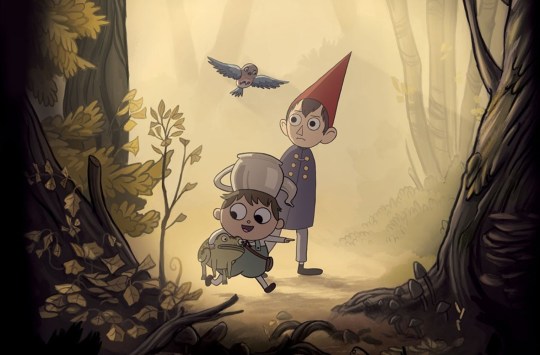
Over the Garden Wall features two half-brothers, Wirt and Gregory, who have become lost in a mysterious wood called The Unknown and attempt to find their way back home.
...
This beautifully crafted animated miniseries is the best thing to come out of Cartoon Network even after ten years. The unique atmosphere, which blends fairytale charm with Gothic eeriness, perfectly compliments the early 20th-century Americana-styled animation. At just ten episodes, Over the Garden Wall is a short but impactful experience that lingers with you long after it ends. I highly recommend this series.
2. Coraline (Film, 2009)

Wandering her rambling old house in her boring new town, an 11-year-old Coraline discovers a hidden door to a strangely idealized version of her life.
...
This stop-motion animated film is a deeply unsettling and visually stunning experience. Blending a dark fairytale narrative with otherworldly imagery, it presents itself as a psychological horror for young and older audiences alike. Coraline explores the complex ideas about family, identity, and the dangers of wish fulfillment with grace. I strongly recommend this film.
3. ParaNorman (Film, 2012)

Norman Babcock, a young boy who can communicate with ghosts, is given the task of ending a 300-year-old witch's curse on his Massachusetts town.
...
This heartfelt stop-motion animated film blends humor, horror, and themes of ostracization and acceptance. While blending classic horror movie tropes with a coming-of-age story, it manages to portray strong themes of prejudice by using zombies, witches, and ghoulish imagery. If you're looking for a unique spin on classic B-movie horror, I highly recommend this film.
4. Happy Death Day (Film, 2017)

A college student must relive the day of her murder over and over again in a loop that will end only when she discovers her killer's identity.
...
Happy Death Day is an entertaining mashup of slasher horror and Groundhog Day-style time loop storytelling. This film stands out from all the rest of the horror-comedy franchise due to its emotion, mystery, and character growth. While it doesn't push boundaries for horror, it makes up for its uniqueness that balances humor and suspense. If you're looking for a horror-comedy film, I strongly recommend this one.
5. Jennifer's Body (Film, 2009)

A newly-possessed high-school cheerleader turns into a succubus who kills her male classmates and devours their flesh in order to survive.
...
Though it was sorely misunderstood when it originally came out, it has recently garnered rightful attention for its subversive take on the horror-comedy genre. This film blends teen drama and supernatural horror and uses its genre to touch upon the objectification of women in horror and in reality. Its wit, self-awareness, and social commentary have made it a standout in the horror-comedy genre, and for that, I strongly recommend this film.
6. Sinister: Recut (Film, 2012)

Ellison Oswalt is a struggling true-crime writer whose discovery of snuff films depicting gruesome murders and strange supernatural elements in his new house puts his family in danger.
...
Said to be one of the scariest films ever from a research study, Sinister is a deeply unsettling horror movie that perfectly mixes supernatural elements with psychological tension. The haunting score combined with the grainy, nightmarish footage of the murders results in an unnerving experience that sits with you long after you turn the lights out. Instead of watching the original movie, I strongly recommend this fanedit version of the film. It elevates the movie by removing some of the cheesy jumpscares and awkward dialog. If you're looking for a genuinely haunting movie this Halloween, I recommend this one.
7. 1408 (Film, 2007)

Author Michael Enslin, who specializes in debunking paranormal occurrences, checks into the fabled room 1408 in the Dolphin Hotel in New York City.
...
This film excels in building suspense, using minimal special effects, and relying on our main characters' isolation and psychological unraveling to create fear. While this movie isn't as overtly terrifying as other horror films, 1408 offers an eerie, slow-burn experience, blending supernatural elements with personal trauma. The film has two different endings, the theatrical version and the director's cut. I'd suggest watching both to come to the conclusion of your favorite. It's a must-watch for fans of psychological horror, and I strongly recommend this film.
8. Midsommar (Film, 2019)

A couple travels to Northern Europe to visit a rural hometown's fabled Swedish mid-summer festival. What begins as an idyllic retreat quickly devolves into an increasingly violent and bizarre competition at the hands of a pagan cult.
...
This is a visually stunning and disturbing horror film set against the backdrop of a bright, idyllic Swedish village. The movie stands out for its unique approach to horror, unfolding almost entirely in daylight, creating a sense of unease through its striking visuals, unnerving atmosphere, and slow-building dread. Midsommar is a polarizing piece of media, mixing folk horror with psychological drama, and is filled with symbolism and unsettling imagery. I highly recommend this film if you're looking to be disturbed this Halloween.
9. Skinamarink (Film, 2022)

A young brother and sister wake up during the night to discover that their father is missing and that the windows, doors, and other objects in their house have vanished.
...
Skinamarink is an experimental analog horror film that trades traditional narrative for a surreal, nightmarish atmosphere. Shot in grainy, low-light cinematography, the film immerses you in a disorienting and eerie world where fear of the unknown takes center stage. The film’s strength lies in its ability to evoke childhood fears, using abstract visuals and unsettling sound design to create a sense of dread. However, its unconventional approach may alienate some people who expect a clear plot or resolution. The minimal dialogue and deliberate pacing make Skinamarink more of a mood piece than a traditional horror film, relying on atmosphere over jump scares. For those willing to embrace its experimental nature, Skinamarink offers a haunting and disquieting experience that lingers long after it ends, tapping into primal fears of isolation and helplessness. For all these reasons, I highly recommend that you check out this film.
10. Heck (Short Film, 2020)

A child wakes up in the middle of the night to the sound of his mom's television blaring.
...
Heck is a short film that shares a similar atmospheric approach to the creator's feature-length film Skinamarink. Like Skinamarink, it explores the feeling of being trapped in a surreal, dreamlike space. The film's minimalist aesthetic, with grainy visuals and a haunting soundscape, creates a disorienting atmosphere that leaves much to the imagination. It builds tension through its slow pacing, relying on the viewer's discomfort with the unknown rather than traditional horror tropes. For people who thought Skinamarink's runtime was excessive, Heck is a great substitute that captures the same atmosphere of the former. I highly recommend this film to people who have enjoyed Skinamarink's take on horror.
#movie recc#movie#movie review#movies#tv reccs#tv recommendations#tv review#tv#tv shows#movie rec list#movie recommendation#film reccs#film recommendations#film#films#horror#horror film#horror review#horror recs#halloween#all hallows eve#happy halloweeeeeeen#coraline#paranorman#scary movies#halloween movies#happy halloween#spooky month#spooky season#otgw
25 notes
·
View notes
Text
Murder Drones: Losing your artificiality
WARNING. Discussion of typical Murder Drones gore and fictional mental conditions. Take care.
There is a trope, pretty much as old as sci-fi itself, where the more one becomes a machine the less human they become. Shadowrun has it as a mechanic, Cyberpunk has its cyberpsychosis and there are many examples where a character forced into a machine body loses their emotions.
To become too much of a machine is to lose your touch with emotions and empathy. In the worst cases, even to your morals. A machine only does what it feels is logical.
So, what would happen if the situation was reversed? What if a machine suddenly started becoming more flesh?
Murder Drones discusses this with its titular drone type and with infected Solver Drones.
Now, the basic worker drone is a very human creature. They have emotions, they have faults and they often aren't logical. They are the concept of an AI replicating humanity put to its logical endpoint. However, even if Uzi mentions hormones, it is all simulated.
Sure, to them it feels real (and let's face it, a lot of our own functions are mostly our brain making stuff up), but it is all code and simulations. Something they could technically turn off at will.
What happens when a worker drone gains flesh through the Solver? If Murder Drones was playing this trope reversal straight, it would result in the drone in question becoming more 'real.'
In a way, that is what happens. But instead of the drones becoming more human in an emotional and moral sense, they instead become more human in a baser way. Or, rather, they become more like a flesh and blood animal. Just like humanity is at its core.
The Disassembly Drones and Solver Drones gain urges that are very real and cannot be turned off. They hunger, they seek out something to satiate themselves and they draw pleasure from the process.
The drones gain an id to their already present ego and super-ego. An id that pushes them to consume and revel in it. Yes, it is used to stall overheating, but the way it appears to affect the drones is clearly also tied to hunger.
While a human becoming more machine loses touch with emotions and empathy, a drone becoming more flesh loses parts of its autonomy. They are now driven by primal urges that affect how they think and how they act. And these urges have no 'off' switch.
This change to the primal is shown with the Disassembly Drones having animal parts (tails, wings, extra eyes, claws, etc.) and some Solver Drones literally creating fleshy parts for themselves.
The way the show depicts this goes into the horror of losing your bodily autonomy and control. But it also goes into how these instincts and urges change you as a person as readily as becoming a machine does.
One loses its humanity to cold logic, the other to primal urges. In both cases, what makes one human is gone.
Using machines as the baseline for a story of primal horror is clever because the wet body horror then stands as a stark contrast to the mechanical and clean default.
This theme of the flesh twisting machines is further depicted through the main villain. The Absolute Solver is a singularity, but everything around it draws more from demonic imagery than the horror of an evil AI. The Solver brings it the horrors of the flesh, wrapped in the guise of sci-fi.
Underneath the exterior of a megacorp and its killing machines, you find vampires, witches, demons and even a form of lycanthropy. Creatures of urban horror, of the flesh.
What makes it all interesting, is how we see Tessa combine the two first in the timeline. She dug up both drone corpses and human ones and combined them by giving her reanimated drones human hair. We also see in her room hints that she was interested in alchemy.
Neither machine nor beast can take such an action, it needs a human to show them how.
Murder Drones proves with its use of subversion and tropes of another genre, that a sci-fi story doesn't need cybernetics to depict the loss of humanity. Humanity's own primal nature can be just as effective.
16 notes
·
View notes
Text
DEITY MASTERLIST (PART TWO)
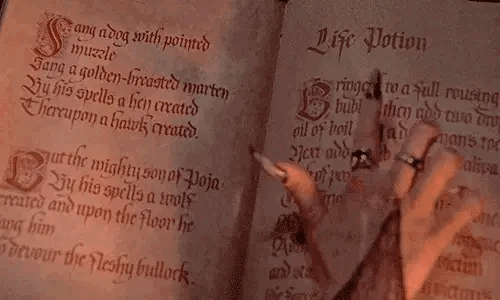
📿 Kuan Yin
Goddess of: mercy and compassion
Culture: Chinese/Buddhist
Symbols: vase, rosary, willow branch, fish basket, and pearls
Plants: lotus, willow, and bamboo
Animals: horse, peacock, dragon, and birds
Colours: white
Tarot: Judgment
Offerings: oranges, pomegranates, spices, oolong tea, incense, and love and compassion for both yourself and others
🌱 Lada
Goddess of: spring, beauty, love, and fertility
Culture: Slavic
Symbols: Lada Star, bells, and Spring Equinox
Plants: linden, dandelion, peony, and birch
Animals: lark, deer, ant, and eagle
Colours: red and white
Tarot: Page of Cups and The Lovers
Offerings: honey, music, mead, apples, sweets, lemon balm, cherries, and chestnuts
🌉 Lilith
Goddess of: love, demons, beauty, wisdom, life, rebirth, fertility, motherhood, inner-strength, illumination, mysteries, spiritual initiation, the night, and The Evening Star
Culture: Demonic
Symbols: sword, pentagram, scythe, moon, dragon, snake, crossroad, dark moon, and pentacle
Plants: apple, poisonous plants (belladonna, hemlock, and mugwort), sandalwood, rose, dandelion, red hibiscus, witch hazel, lilac, and patchouli
Animals: black cats, snakes, owls, dogs, spiders, bats, and goats
Colours: red, black, purple, blue, green, silver, and gold
Tarot: The Devil
Offerings: black candles, black stones, or black crystals, honey, champagne, seductive perfume, fancy jewelry, tea, exercise, having sex and/or masterbating, swords and daggers, pomegranates, dark chocolate, sex toys or other items related to sex and pleasure, dragon’s blood, flowers and herbs: lilies, red roses, sage, basil, mugwort, and rose, dancing, red wine, clay, depictions of owls, snakes, cats, dogs, bats, dragons, and spiders, mirrors, apples, red or black silk, and poetry.
🤘 Loki
God of: mischief and trickery
Culture: Norse
Symbols: serpents, wolves, ax, raven, masks, fire, Bjarken and Logr Runes, fishing nets, earthquakes, infinity snake and ouroboros, number 8, chaos star, runes that spell out his name: Laguz, Othala, Kenaz, Isa as well as the rune Hagalaz, and Helmet of Dread or the Helmet of Horror
Plants: mistletoe, birch, common Haircap moss (Loki’s Oats), bentgrass (Loki’s Grass), cinnamon, dandelion, beech, blackthorn, elder, elm, ivy, juniper, mullein, thistle, mint, holly, cedar, juniper, elder, clove, patchouli, tobacco, willow, and yew
Animals: salmon, crows, , ravens, falcon, vulture, flies, goats, flea, horses, wolves, foxes, and spiders
Colours: green, gold, black, violet, yellow, orange, and red
Tarot: The Fool, The Tower, The Devil, The Wheel of Fortune, Page of Cups, and Seven of Swords
Offerings: candles, especially black ones, incense, a musky or mysterious scent would be appropriate, red fruits or flowers, gems or metals, herbs, such as dill, ginger, and mugwort, art or poetry, toys, such as the ones you used to play with as a kid, acts of chaos, subversion, or mischief, flowers: daisies, roses, and lilies, crystals, hanging mistletoe at Yuletide, foods and drinks: sweet foods, alcohol, spicy rum, candy, mulled wine, chocolate with nuts or funny names, spongecake, coffee or other caffeinated beverages, honey, and pastries, knives and daggers, doing something you are scared of (safely), and cinnamon.
🌅 Lucifer
God of: illumination, light, darkness, change, rebirth, challenges, innovation, logic, truth, knowledge, wisdom, strategy, persuasion, revolution, luxury, pleasure, freedom, The Arts and The Morning Star (“Morning Star” is another name for the planet Venus)
Culture: Demonic, Pagan, and Greco-Roman
Symbols: Sigil of Lucifer, The Morning Star, violins and fiddles, dragons, wings, serpents, black goats, inverted pentagram, light, and the pentacle.
Plants: belladonna, mulberry, patchouli, myrrh, min, tobacco, marigold, lilies, hyacinth, rosemary, and black poppies, lavender, mint, blackberries, sage, apples, pomegranates, lilac, rose, black pepper, hyssop, gardenia, geranium, garlic, yarrow, and cypress.
Animals: black animals in general, snakes, spiders, ravens, wolves, dragons, eagles, crows, goats, bats, rats, moths, flies, peacocks, insects, and swans.
Colours: blue, red, black, gold, emerald green, and silver.
Tarot: The Devil.
Offerings: candles or torches, sweet treats like dark chocolate or pastries, red, black, or dead roses, incense like sage or cinnamon, red wine, whiskey, especially Jack Daniels, champagne, pomegranate/pomegranate juice, black tea, especially earl grey, cooked goat meat, venison, apples, honey, good quality cigars, tobacco, daggers and swords, silver rings, emeralds and emerald jewelry, goat horns, black feathers, seductive colognes, crow skulls, bone dice, devotional poetry and artwork, and classical music, especially violin.
🦁 Lugh
God of: the Sun, The Arts, storms, The Harvest, oaths, Kings, justice, craftsmanship, smithcraft, light, and warriors
Culture: Celtic
Symbols: spear, harp, and slingshot
Plants: apple, oak, hazel, holly, marigold, goldenrod, sunflower, carnation, rose, gorse, bay, basil, allspice, rosemary, and cinnamon
Animals: lion, horse, raven, stag, crow, hound, and lynx
Colours: brown, gold, yellow, green, red, and blue
Tarot: The Emperor, Justice, Strength, The Sun, and Suit of Wands
Offerings: wine, mead, apple cider, corn, bread, apples, berries, potatoes, beer, harvested fruits and vegetables, corn dolls, cloves, gorse flowers, and handmade crafts
🪐 Ma'at
Goddess of: truth, justice, cosmic order, harmony, wisdom, morality, and balance
Culture: Egyptian
Symbols: scales, ostrich feathers, Ankh
Plants: papyrus
Animals: vulture and ostrich
Colours: purple and black
Tarot: Justice, Temperance, and Judgment
Offerings: no drugs and alcohol, cold water, tea with milk, dates, plums, fish, chicken, olive oil, vinegar, hummus, barley biscuits, reeds, gold jewelry, and white linen.
🦭 Manannan Mac Lir
God of: the sea, weather, navigation, and Guardian of the Otherworld
Culture: Celtic
Symbols: cups, cloak, a silver branch with three golden apples on it, and mermaids
Plants: alder, apple, hazel, blackberry, bramble, reed, meadow grass, yellow flowers, and seaweed
Animals: horse, pig, cow, seal, crane, swan, boar, dog, dolphin, sea horse, and whale
Colours: blue, silver, and gold
Tarot: The Chariot
Offerings: yellow flowers, sea water, bread, ale, and mead.
🌒 Máni
God of: personification of the Moon and protector of children and the mentally ill
Culture: Norse
Symbols: silver, the Moon, and astrology
Plants: jasmine, carnations, night-blooming flowers, and aromatic flowers
Animals: horse, rabbit, and wolf
Colours: blue, silver, black, lavender, and white
Tarot: The Moon
Offerings: peppermint-flavored sweets, peppermint Tea, angel food cake, relaxing tea, and salt
♟️ Marduk
God of: justice, compassion, war, healing, magic, storms, and agriculture
Culture: Mesopotamian
Symbols: lightning, war chariot, and weapons
Plants: grain
Animals: horse, dog, dragon, and eagle
Colours: gold
Tarot: The Emperor
Offerings: beer, ale, daggers, golden jewelry, bread and grains, coffee, artwork and poetry, feathers, meat, and fruit.
🕯️ Medea
Goddess of: Witch and Priestess of Hecate, invoke for justice, vengeance, and protection
Culture: Greek
Symbols: poisons, cauldrons, and golden fleece
Plants: juniper, olive, and wolf’s bane
Animals: dragon and snake
Colours: gold and white
Tarot: The Magician
Offerings: wine, frankincense, milk, honey, poisons, artifacts of Witchcraft, flowers, and snake and dragon imagery.
🤰 Mokosh
Goddess of: spinning, weaving, fiber arts, moisture, shearing, protection, childbirth, spell casting, fate, fertility, life, death, and rebirth
Culture: Slavic
Symbols: mokosh tones, rain, solar and earthly symbols
Plants: local seasonal plants
Animals: sheep, cat, and horse
Colours: gold, white, and red
Tarot: The Empress
Offerings: personal needlework, wool and flax, grains and bread, salt, oilseeds, dairy, berries, eggs (especially Pisanki), porridge, milk, honey, herbs, fruits, vegetables, a lock of your own hair, and locally sourced seasonal crops.
☃️ Morana
Goddess of: winter, death, and rebirth
Culture: Slavic
Symbols: poppets (spell dolls) and water
Plants: evergreen, berries, grass, rosemary, cypress, wormwood, mandrake, and elderberry
Animals: snake
Colours: white, red, black, and grey
Tarot: Death
Offerings: tea, water, rocks, bones alcoholic beverages, bread, oats, seeds, fruit, and homemade foods and baked goods.
🪄 Morgan le Fay
Goddess of: Witchcraft
Culture: Welsh/Arthurian
Symbols: artifacts of Witchcraft
Plants: honeysuckle, henbane, reed, aspen, oak, and willow
Animals: crow, crane, raven, black dog, horse, cow, and wolf
Colours: red, black, and lavender
Tarot: The Moon and The Magician
Offerings: red ribbons, crow and raven feathers, whiskey, rum.
✊ Nemesis
Goddess of: retribution, fairness, and Punisher of Hubris
Culture: Greek
Symbols: sword, lash, dagger, scales, and apple branch
Plants: Apple Tree, Thistle
Animals: griffin and goose
Colours: red, black, silver, gold
Tarot: Justice
Offerings: wine, olive oil, water, fruit, honey, milk, feathers, apple seeds, apple blossoms, bones, scales, chains, daffodils and narcissus flowers.
😷 Nergal
God of: war, death, plagues and disease
Culture: Mesopotamian
Symbols: lion-headed Mace and sword
Plants: thistle, grapefruit, and pomegranate
Animals: lion, bull, and bat
Colours: red, black, silver, and gold
Tarot: The Tower, The Devil, and Death
Offerings: animal bones, thorn branches, bitter lemonade, absinthe, and pomegranate juice.
🏋️ Nike
Goddess of: victory
Culture: Greek
Symbols: balm branch, wings, a wreath, sash, and lyre
Plants: palm tree and laurel tree
Animals: horse
Colours: silver, gold, and blue
Tarot: Wheel of Fortune, Justice, and Strength
Offerings: feathers, trophies, medals, palm branches or leaves, and athletic equipment.
🪴 Ninhursag
Goddess of: the Earth, motherhood, childbirth, fertility, nourishment, agriculture, and vegetation
Culture: Mesopotamian
Symbols: omega symbol, bow, and mace
Plants: all grown vegetation
Animals: Cow, Lion, Fish, Serpent
Colours: green, gold, white, and silver
Tarot: The World, The Empress, Suit of Pentacles, and Queen of Pentacles
Offerings: wine, beer, fresh water, cooked fish, eggs, vegetarian foods, bread, honey, butter, myrrh, and all flowers.
🐚 Njörð
God of: the sea, the wind, abundance, and wealth
Culture: Norse
Symbols: ships
Plants: avens, ferns, oak, oak moss, polypody, verbena, rosemary, reeds, and bay
Animals: fish and aquatic creatures
Colours: blue
Tarot: King of Cups
Offerings: fish, seafood, pork, chocolate coins, sea salt chocolate, dark beer, gin, golden items, beads, shells, tobacco, and fishing gear.
🌃 Nut
Goddess of: night
Culture: Egyptian
Symbols: Ankh and water pot
Plants: sycamore and fig
Animals: boar, cow, vulture, and hippo
Colours: dark blue
Tarot: The Star
Offerings: milk, cool water, star-shaped foods, blue goldstone, and blue flowers
🌌 Nyx
Goddess of: the night
Culture: Greek
Symbols: crescent moon, mist, darkness, and stars
Plants: poppies, night blooming lilies, moon flowers, and gladiolus
Animals: owl, crow, and bat
Colours: dark blue and black
Tarot: The Star
Offerings: milk, black coffee or tea, dark chocolate, silver jewelry, dragon fruit, dew gathered before the sun rises, wine, dark beer or liquors, and starry and celestial items.
📖 Odin
God of: wisdom, healing, death, royalty, the gallows, frenzy, knowledge, war, battle, victory, sorcery, poetry, and Runic alphabet
Culture: Norse
Symbols: valknut, right-legged horse (Sleipnir), wolves, ravens, spear (Gungnir), and the Othala Rune
Plants: mugwort, plantain, wormwood, chamomile, pine, apple, fennel, juniper, elfwort, and wotan’s herb
Animals: wolf, raven, snake, bear, and horse
Colours: grey, deep blue, and black
Tarot: The Hermit, The Magician, and The Hanged Man
Offerings: red wine, mead, beer, ale, quality alcohol, whiskey, smoked salmon, red meat, beef, leeks, asparagus, garlic, and honey
💦 Ọṣun / Oshun
Goddess of: water, purity, fertility, love, sensuality, freshwater, wealth, diplomacy, and The Osun River
Culture: Yoruba
Symbols: seashells, and amber beads
Plants: cinnamon, sunflowers, oranges, yellow squash, marigold, pumpkin, rosemary, and lantana
Animals: peacock, vulture, catfish, river fish in general, cricket, leopard, and crocodile
Colours: white, gold, amber, yellow, and coral
Tarot: The Empress
Offerings: honey (taste before you offer it) , bowl of water, flowers, seashells, beauty items, chamomile tea, cooked shrimp and spinach, yellow and orange fruits and vegetables, sliced orange drizzled with tasted cinnamon honey.
⚰️ Osiris
God of: the Underworld, death, resurrection, fertility, and agriculture
Culture: Egyptian
Symbols: crook and flail, atef crown, ostrich feathers, mummy gauze, and djed
Plants: willow, tamarisk tree, and many types of houseplants
Animals: bull, ostrich, and dog
Colours: black and green
Tarot: The Emperor, The Hierophant, The Lovers, The Hanged Man, Death, and Judgment
Offerings: green and black crystals, bread, beer, beef, bird meat, and nice clothing
🌫️ Ọya
Goddess of: weather, death and rebirth, a psychopomp, and patron of the Niger River
Culture: Yoruba
Symbols: lightning, sword, machete, and fly-whisk
Plants: akoko tree, camwood, camphor, cypress, marigold, and mimosa
Animals: water buffalo, antelope, sheep, and locust
Colours: purple, burgundy, and the rainbow
Tarot: Strength, The High Priestess, and The Empress
Offerings: starfruit, black-eyed peas, plums, purple grapes, mine eggplants is a traditional offering (or one eggplant sliced into nine pieces), and red wine
🐐 Pan
God of: the wild, shepherds, flocks, rustic music, fertility, hunters, mountains, forests, and meadows
Culture: Greek
Symbols: panpipes
Plants: Coriscan Pine, Water-reed, Pine Trees
Animals: goat
Colours: green, brown, and purple
Tarot: The Fool, The Lovers, The Devil, King of Pentacles, and Page of Pentacles
Offerings: pine cones, pine branches, animal bones, musical instruments (especially Woodwinds), milk, honey, and lamb or goat meat
🌋 Pele
Goddess of: volcanoes, fire, Land lightening
Culture: Hawaiian
Symbols: volcano, fire, and lava
Plants: ohi’a lehua, lehua lower, strawberry, sugar cane, tobacco, coconut, and pineapple
Animals: Hawaiian honeycreeper, sea turtle, fish, and white dogs
Colours: red, orange, yellow, green, and black
Tarot: The Tower and Suit of Wands
Offerings: fruits, flowers, forest plants, berries, vegetables, gin, and cigars
⚱️ Persephone
Goddess of: the Underworld and spring
Culture: Greek
Symbols: pomegranate, grain, torch, and flowers
Plants: asphodel wheat, willow, narcissus, lily, ivy, lily of the valley, daisy, and lavender
Animals: deer, bat, black ram, parrot, and monkey
Colours: green, black, light blue, purple, magenta, indigo, and yellow
Tarot: The Hermit, The Hanged Man, Death, Judgment, and Knight of Pentacles
Offerings: pomegranates/pomegranate juice, honey, floral tea, breads and sweets, flower crowns or arrangements, dark chocolate, flowers, crushed mint, animal bones, jewelry, and/or your artwork
🌊 Poseidon
God of: the sea, water, horses, and earthquakes
Culture: Greek
Symbols: trident
Plants: pine tree and wild celery
Animals: fish, dolphin, horse, and bull
Colours: blue, teal, green, and silver
Tarot: King of Cups and Suit of Cups
Offerings: ocean water, honey, olive oil, seaweed, white wine poured into water, wild celery, homemade seafood, seashells, sea salt, coral, mint, and sand
☀️ Ra
God of: creator god, and the sun
Culture: Egyptian
Symbols: sun disk, ankh, , and sceptre
Plants: citrus fruits, marigold, sunflower, papyrus, daisy, and lotus
Animals: falcon, lion, and eagle
Colours: yellow, gold, orange, red, and white
Tarot: The Emperor and The Sun
Offerings: fruit juice, citrus fruits, honey, water, beer, wine, bread, barley, figs, dates, chocolate, chicken or duck, beef, and frankincense.
🚢 Rán
Goddess of: the sea
Culture: Norse
Symbols: Fishing Nets, Stormy Seas
Plants: beech, buckthorn, elder, elm, ivy, juniper, willow, and yew
Animals: aquatic Animals
Colours: black an sea-green
Tarot: Queen of Cups
Offerings: clean up the ocean, seashells, fishing with a net, seafood, gold, coins, sea rocks, flowers, sand, seawater, bread? cakes, and mead
🐎 Rhiannon
Goddess of: the moon, horses, songbirds, wind, gates, and horseshoes
Culture: Welsh
Symbols: the moon, horseshoes, waning moon phases, gates, the winds, and the number 7
Plants: cedar, pine, narcissus, daffodils, pansies, rosemary, sage, bay, lavender, and all white flowers
Animals: horse, frog, dog, songbird, dragon, badger, and hummingbird
Colours: green, silver, black, white, grey, red, maroon, and brown
Tarot: The Moon
Offerings: soft-sounding music, a white candle with the number 7 carved into it, white flowers, apples, willow, ivy, evergreens, caring for horses, caring for dogs, and studying liminal spaces and astral work
💀 Santa Muerte
Goddess of: healing, protection, financial wellbeing, and the afterlife
Culture: Mexican
Symbols: scythe, globe, scales of justice, and oil lamp
Plants: fresh flowers, apples, and marigolds
Animals: owl, dogs, cats, dove, crows, and snakes
Colours: red, white, black, blue, and green
Tarot: Death
Offerings: cash, cigars, apples, tequila, cannabis, fresh water, candles, candy, fruit, roses, and bread
🌙 Selene
Goddess of: the Moon
Culture: Roman
Symbols: crescent, torch, chariot, billowing cloak, bull, stars, moon, horse, lunar cycle, torch, and bull horns
Plants: willow, moonflower, lavender, wisteria, oak, lilac, birch, rose, dandelion, and jasmine
Animals: horse, bull, mule, and ox
Incense: frankincense, rosemary, guaiac, orris root, and tonka bean
Colours: silver, blue, white, and grey
Tarot: The Moon, The Star, and Temperance
Offerings: white foods, moon water, dew, glitter/shiny objects, olive oil, flowers, fruit, moon-shaped things, water, honey, nephalia (wineless libation), milk, statues of horses, cakes, and crystals (moonstone, quartz, selenite, and pearl)
🦁 Sekhmet
Goddess of: war, destruction, healing, divine wrath, fire, and the sun
Culture: Egyptian
Symbols: the sun, scimitar, ankh, the desert, and pomegranates
Plants: carnation, rose, cloves, cinnamon, juniper, and orange blossoms
Animals: lion and cobra
Colours: red, gold, yellow, and white
Tarot: Strength, The Tower, and The Sun
Offerings: red wine, rum, beer, meats, bones, tobacco, wild cat skulls, weapons like daggers and swords, pomegranates, spicy foods, gold Jewelry, red Flowers, milk, blackberries, raspberries, mushrooms, and bread
💣 Set
God of: the sky, storms, the desert, disorder, war, foreigners, and a trickster God
Culture: Egyptian
Symbols: was sceptre and ankh
Plants: lettuce
Animals: hippopotamus, crocodile, scorpion, snapping turtle, wild pig, and donkey
Colours: red
Tarot: The Chariot, Death, and The Devil
Offerings: beer, whiskey, red wine, spicy foods, red meats, lettuce, shellfish, maces and daggers, bird eggs, cherries, dark chocolate, and shiny things
🪞 Sif
Goddess of: grain and fertility
Culture: Norse
Symbols: golden hair, loom, and mirror
Plants: birch, chamomile, fir, hawthorn, mugwort, rose, and willow
Animals: songbirds
Colours: gold and green
Tarot: Suit of Pentacles and Queen of Pentacles
Offerings: beer, honey, mead, grain, and bread
🎿 Skaði
Goddess of: winter, wilderness, mountains, bowhunting, and skiing
Culture: Norse
Symbols: skis, bow and arrows, snow, mountains, frost, and snowshoes
Plants: beech, blackthorn, elder, elm, ivy, juniper, mullein, and willow
Animals: wolf
Colours: white and brown
Tarot: The Hermit and Temperance
Offerings: vodka, traditional Scandinavian foods, meat from hunted animals (rabbit, deer, etc.), animal pelts, animal bones, and snow Water
🌞 Sól / Sunna
Goddess of: the Sun
Culture: Norse
Symbols: the Sun and gold
Plants: chamomile, cinnamon, corn, daisy, marigold, citrus fruits, rosemary, sunflower, and wheat
Animals: horse
Colours: gold, red, yellow, orange, white, and green
Tarot: The Sun
Offerings: mead, honey, bread, cider, and fruit juice
🪦 Thanatos
God of: personification of death
Culture: Greek
Symbols: sword, inverted torch, theta, wreath, wings
Plants: poppy and cypress
Animals: butterfly
Colours: black, silver, white, and purple
Tarot: Death
Offerings: (traditional liquid offerings are poured into the ground and food is buried), red wine, olive oil, water, honey, poppy seeds, black tea, dark chocolate, feathers, animal bones, snake skin, and graveyard dirt (collected respectfully)
🍃 The Dagda
God of: fertility, agriculture, strength, magic, druidry, wisdom, father-figure, King and Druid
Culture: Celtic
Symbols: club, cauldron, and harp
Plants: grains and oats
Animals: pig and bull
Colours: black, silver, white, and purple
Tarot: Strength, Wheel of Fortune, The World, King of Pentacles, King of Wands
Offerings: Porridge, Mead, Milk, Honey, Pork, Beef, Mutton, Music, and Laughter
Offerings: honey, olive oil, sweets, flowers, herbs, plants, bread, wheat, fruit, sunflower oil, beer, mead, spring water, vegetables, grains, and baked goods
🔮 The Morrigan
Goddess of: magic, battle, life and death, sovereignty, fresh water, prophecy, and fate
Culture: Celtic
Symbols: cloak, spear, chariot, sword, and shield
Plants: willow, aspen, rowan, snapdragon, hawthorn, yew, belladonna, mugwort, and nightshade (do not consume, handle with care!)
Animals: crow, raven, horse, eel, serpent, and wolf
Colours: red, black, white, blue, and green
Tarot: Suit of Swords, Queen of Swords, Justice, and Death
Offerings: red meat, red wine poured into the ground, apples, mead, milk, whiskey, storm water, crow feathers, knives and daggers, and artwork
🌩️ Thor
God of: thunder, lightning, strength, protection, fertility, masculinity, and protector of humanity
Culture: Norse
Symbols: Mjölnir
Plants: oak, garlic, onion, gorse, thistle, hawthorn, leeks, houseleek, mountain ash, hazel, pine, acorns, and oak moss
Animals: goat and bull
Colours: red, white, gold, and blue
Tarot: Strength and The Chariot
Offerings: hearty foods with lots of meat or onions, mead, beer, flattery, oak, whiskey, coffee, and honey
✒️ Thoth
God of: knowledge, wisdom, writing, mathematics, science, magic, truth, integrity, time, and the moon
Culture: Egyptian
Symbols: scales, papyrus scroll, stylus, crescent moon, and a pen
Plants: papyrus and sweet flag
Animals: ibis and baboon
Colours: white, blue, and teal
Tarot: The Magician, The Hierophant, The Star, and The Moon
Offerings: black tea, water, honey, blackberries, apricots, salmon, tuna, oranges (and orange-flavoured things), walnuts, cashews, quills, fountain pens, leather-bound books and journals, books you think he’d enjoy, silver, poetry, dark chocolate, whiskey, gin, mead, mint tea, and moon water
🗡️ Tyr
God of: war, lawgiver, justice, oaths
Culture: Norse
Symbols: weapons like arrows and spears
Plants: flowering spurge, holly, wolfsbane, and monkshood
Animals: wolf, bear, and eagle
Colours: red, silver, grey, and gold
Tarot: King of Swords
Offerings: wine, strong beer, salt, honey, bread, grains, beef, pork, and potatoes
🐄 Veles
God of: the Underworld, Earth, water, music, magic, trickery, cattle, and wealth
Culture: Slavic
Symbols: the symbol of Veles
Plants: willow
Animals: cow, bear, snake, wolf, dragon, and owl
Colours: gold, yellow, and red
Tarot: The Magician, The Hierophant, The Star, and The Moon
Offerings: cooked corn, bread, herbs (especially basil), wooden flutes and string instruments, black wool or fur, things carved from wood, coins, chicken, mistletoe, and music,
🌧️ Zeus
God of: King of the Gods, the sky, weather, law, order, justice, hospitality
Culture: Greek
Symbols: lightning bolt, cloud, sceptre, throne, and aegis
Plants: oak, olive, wild celery, artichoke, white poplar, and linden tree
Animals: eagle, bull, cuckoos, and swan
Colours: gold, yellow, blue, white, purple, and silver
Tarot: The Emperor, Justice, Wheel of Fortune, King of Swords, and The Fool
Offerings: wine, olive oil, water, honey, milk, red meat, bread and cakes, rainwater, golden objects, crowns, scales, eagle feathers, oak branches and leaves, beef or mutton, whiskey, and cinnamon.
#fyp#fypシ#fypシ゚viral#fypage#fyppage#tumblr fyp#satanism#satanist#deity#deity work#deity worship#occult#information#long post#gods#goddesses
46 notes
·
View notes
Note
Hiii! For your lovely fae boys for the ask game:
⏮️💬📓
And in general:
🌒🎭
Sigh ur au's rotate in my brain I just love how affectionate they are!!
Hello, dearie!!! Thank you for the questions! @rosescarletful
Here we go:
⏮️ - If you could go back and rewrite any parts of your AU, would you? What would you change? Looking back, I could make some parts of the chapters of Extended Contract a bit longer, however I do also like this where it is progressively getting longer (and more intense storywise). I really like where the story is going so far and I cannot wait to post more chapters.
💬 - How would you describe this AU to a friend who wasn’t in the DCA fandom? A jaded light witch accidentally reveals their true name to a pair of royal Fae that had come to abduct them from a law firm that is run by an evil warlock. Wishing to find a solution for their current situation, the light witch begins a mental game of bargaining with the unhinged Fae King to win back their freedom, but things take a turn and new alliances are forged as the light witch obtains revelations of both their past life and the immortal love they had shared with the royal Fae brothers that transcends time and space. Together, they will work to rebuild what was once torn and broken.
📓 - Show us a current WIP for your AU!
“Is this really necessary?“
“Royal etiquette and tradition. Courtly gallantry is of crucial importance. Additionally, one must demonstrate refinement and confidence through their movement, the ability to command attention. You never know what diplomatic affairs or arrangements may be struck in these close encounters where you have to whisper sweet nothings to the other party as you sway them in every sense of the term.“
You blinked at him.
“It's my birthday, Sun. If I want to sit in the corner with a glass of brandy without elaborating anything, then everyone else in the Celestial Court will just have to deal with it.“
🌒 - Do you prefer Sun & Moon to be separate animatronics or share the same body? I prefer to make them separate and I love to also add Eclipse in the mix to complete the collection haha. I love the dynamics and personality clashes when all three of them are interacting both with Y/N and each other, it is so fun to explore and I can have their conversations in my head for hours.
🎭 - Tell us one cliche/trope you love in AUs and one you dislike. I like to use subversion of tropes a lot, I do this particularly in Tip the Scales a lot, as well as in Sound the Bells. Placing old concepts in completely new situations, it is so fun, especially with also giving everyone an existential crisis while doing it.
Thank you so much for the questions and have an amazing day, dear!
#sundrop x reader#moondrop x reader#eclipse x reader#sundrop#moondrop#eclipse#fnaf eclipse#fae sun#fae moon#fae eclipse#fae king eclipse#five nights at freddy's#the daycare attendant#daycare attendant x reader#daycare attendant#jester's privilege chronicles#amary's chronicles#amary speaks#amary answers#dca fandom#dca community
14 notes
·
View notes
Text
5. yamanba gyaru
yamanba gyaru is a bold and extreme substyle of the gyaru fashion movement that originated in Japan in the late 1990s and early 2000s. it is characterized by its striking and unconventional appearance, which challenges traditional beauty norms. here's the details breakdown of yamanba gyaru fashion!!!!!!!!!!!!!!
origins and development
yamanba gyaru evolved from the earlier gyaru substyles, particularly ganguro, which emphaszied tanned, bleached hair, and heavy makeup. the term yamanba refers to a mythical mountain witch in Japanese folklore, highlighting the wild and exaggerated nature of the style. this substyle emerged as a rebellion against traditional Japanese beauty standards and societal expectations, embracing a more radical and expressive and societal expectations, embracing a more radical and expressive form of self identity. it gained popularity among Japanese youth who sought to stand out and make a bold statement.
key motifs
deep tan and white makeup: one of the most distinctive features of yamanba gyaru is the deep, artificial tan combined with white makeup accents/ white eyeshadow, white eyeliner, and white lipstick or concealer are used to create a dramatic contrast against the tanned makeup.
bleached or colored hair: hair is typically bleaches to a platinum blonde or dyed in bright, unconventional colors like neon pink, blue, or purple. hairstyles are often voluminous and styled in waves or curls.
bold and colorful makeup: besides the white accents, yamanba gyaru makeup includes heavy use of colorful eyeshadows, dramatic false eyelashes, and thick eyeliner.
layered and flashy clothing: the clothing in yamanba gyaru fashion is eclectic and vibrant. it often includes layered outfits with bold patterns, neon colors, and flashy accessories like large hair clips, beads, and chunky jewelry.
platform shoes: oversized platform shoes and boots are a staple in yamanba gyaru fashion, adding to the exaggerated and towerlinh appearance
music
the yamanba gyaru aesthetic is often associated with energetic and rebellious music genres such as j-pop, eurobeat, and para para music. these genres complement the lively and bold nature of the fashion
here are some artists to listen too
Kiryu
BiS (Brand-new Idols of Succession)
GANG PARADE
PassCode
SCANDAL
Yoyoka
The GazettE
Dadaroma
DOLL$BOXR
X JAPAN
movies
yamanba gyaru fashion hasn't been prominently featured in mainstream movies, but it aligns with the subverse and countercultural themes found in certian Japanese films and media that explore youth rebellion and identity. documentaries and features on Japanese street fashion often showcase yamanba gyaru as part of the broader gyaru subculture
here are movies I suggest
Kamikaze Girls (2004)
Love Exposure (2008)
Tokyo Gore Police (2008)
Female Prisoner 701: Scorpion (1972)
Tokyo Tribe (2014)
Suicide Circle (2002)
Death Powder (1986)
Tokyo Vampire Hotel (2017)
book and other media
manga and anime: some manga and anime feature characters inspired by gyaru substyles, including yamanba. titles like gals! by mihona fuiji provide a glimpse into the gyaru lifestyles and fashion.
magazines: magazines such as egg have historically featured yamanba gyaru, providing fashion tips, makeup tutorials, and showcasing street snaps of those embarrassing the style.
social media and online communities: platforms like Instagram and TikTok, and various fashion blogs have become essential for yamanba gyaru enthusiasts to share their looks, connect with like minded individuals, and keep the subculture alive. online communities and forums dedicated to gyaru fashion also play a significant role in fostering the yamanba gyaru community.
moodboards

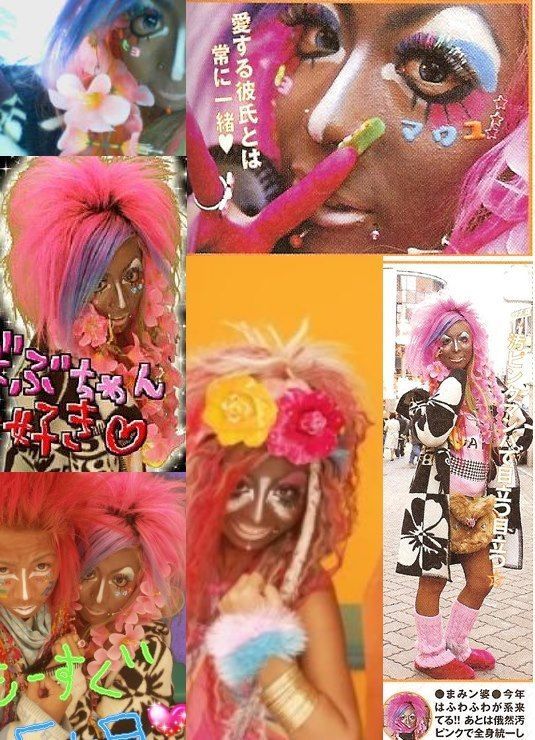
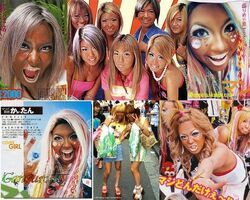

outfit inspo
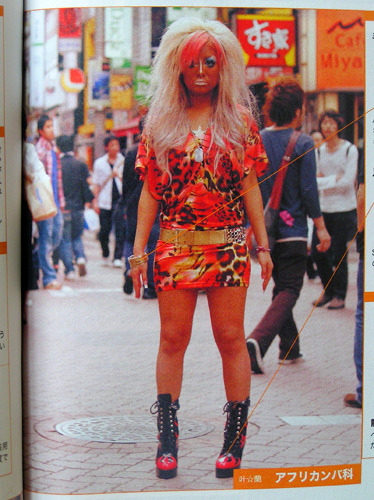
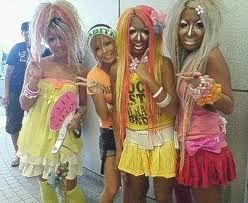


overall, yamanba gyaru is a radical and expressive fashion subculture that embraces bold colors, exaggerated makeup, and a rebellious spirit. it challenges conventional beauty standards and celebrates individuality and creativity.
make sure to like, reblog if you want and follow my blog for more fashion breakdowns like this!!! my requests are open aswell:)))
videostar signing off...............
#films#cinema#fashion#fashionblogger#style#movies#movie poster#i love this movie#favorite movies#femcel#gyaru fashion#hime gyaru#gyarustyle#gyaru#gyaru gal#kogal#gyaru makeup#yamanba gyaru#yamanbagiri chougi#yamanbagiri kunihiro#manba#manba gyaru#sucy manbavaran#man bat#manbagi rumiko#kuro gyaru#tsuyome#heisei gyaru#ganguro#girl blogger
21 notes
·
View notes